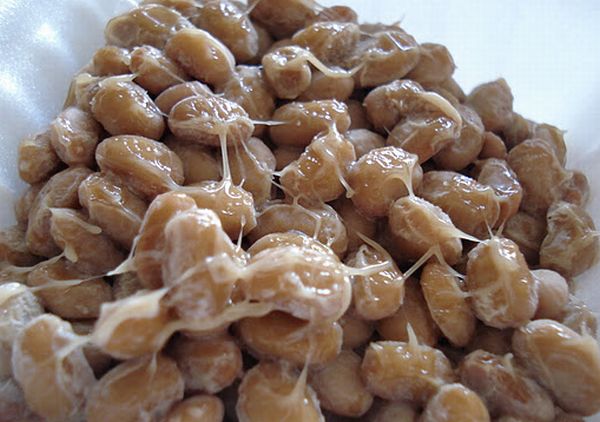Origin of the dish
Natto is the staple food of Japanese for more than 1000 years, originally being consumed in breakfast. The term “nat” itself means “to offer” and “to” means “beans”. There are at least five theories as to the origin of natto, although none of them are much conclusive. However, they all seem to agree that natto is a food which promotes good health and long life.
The cuisine
This is a traditional Japanese dish made out of fermented soybeans and gives out a very strong smell, almost like old and pungent cheese. It is generally eaten along with rice, having a distinctive flavor. It is very sticky on its surface. The longer you stir it, the stickier natto becomes and it is generally poured over the rice with a choice of seasonings.

The wacky tinge
It is smelly and one can instantly guess if someone has opened a natto packet. The production process of natto entails the soybeans being soaked thoroughly, cooled and wrapped with straw and kept in a warm place. This ferments the soybeans by a bacterium reaction as bacteria thrives in the straw and ferments the soybeans. There are so many ways of eating natto, if you can not take in as it is. Despite the smell, natto grows on you as you get to appreciate the sharp and nutty flavor.No wonder, the Japanese cling to it as a comfort food which is very nutritious. Like everything else, natto can become an acquired taste as many Westerners are now relishing this dish as it has many beneficial aspects.
Ingredients
In order to make natto, you will require:
a. Soybean
b. Dried rice straw
Process
a. Soybean is soaked in water until it stops swelling. The time taken for this could be one full day in winter and just one night in summer.
b. Boil or steam the soybeans until they soften. Steaming is highly recommended as boiling tends to peel the thin skin of the beans and makes its taste flow out. A pressure cooker is more suitable for quick cooking of the beans.
c. The dried straw has to be put in boiling water for several minutes to sterilize. The natto bacillus in the straw can survive for more than 10minutes in hot water of 100 degree Celsius.
d. Make the straw packages enough to hold 50 grams of beans each.
e. Put the cooked beans into straw packages, cover with straw and tie it up.
f. Store the package at 108 degree Fahrenheit and ensure that there is enough oxygen supply as natto fermentation requires enough oxygen. It is kept this way for at least 24 hours.
g. Fermentation takes place during within one to two days.
h. After this, the natto is cooled and kept in the refrigerator for about a week. This process helps in the stringiness of the natto.
i. During refrigeration at 0 degree Celsius, spores are developed by the bacilli and the enzymatic peptidases starts breaking down the soybean. This develops the desired constituent amino acids of natto.
In case you have the natto bacilklus culture, straw is not required as you can sprinkle the bacillus powder with hot water on the cooked soybeans. You can then store the beans in a container and keep it slightly open for air. You can also use the Japanese natto product as the mother bacillus culture.
Health benefits
Older people in Japan truly believe that natto prolongs life. This may be attributed to the essential nutrients and vitamins present in this smelly dish. Soybean on its own is full of Vitamin K and protein, while other essential enzymes and acids like pyrazine and lecithin develop during the process of fermentation. Daily intake of natto is believed to prevent cancer, osteoporosis and maintains healthy blood vessels. This enables proper blood flow in the body, preventing blood clots and thereby most beneficial for the heart. It also keeps your digestive system regulated and is very beneficial for a healthy kidney.


